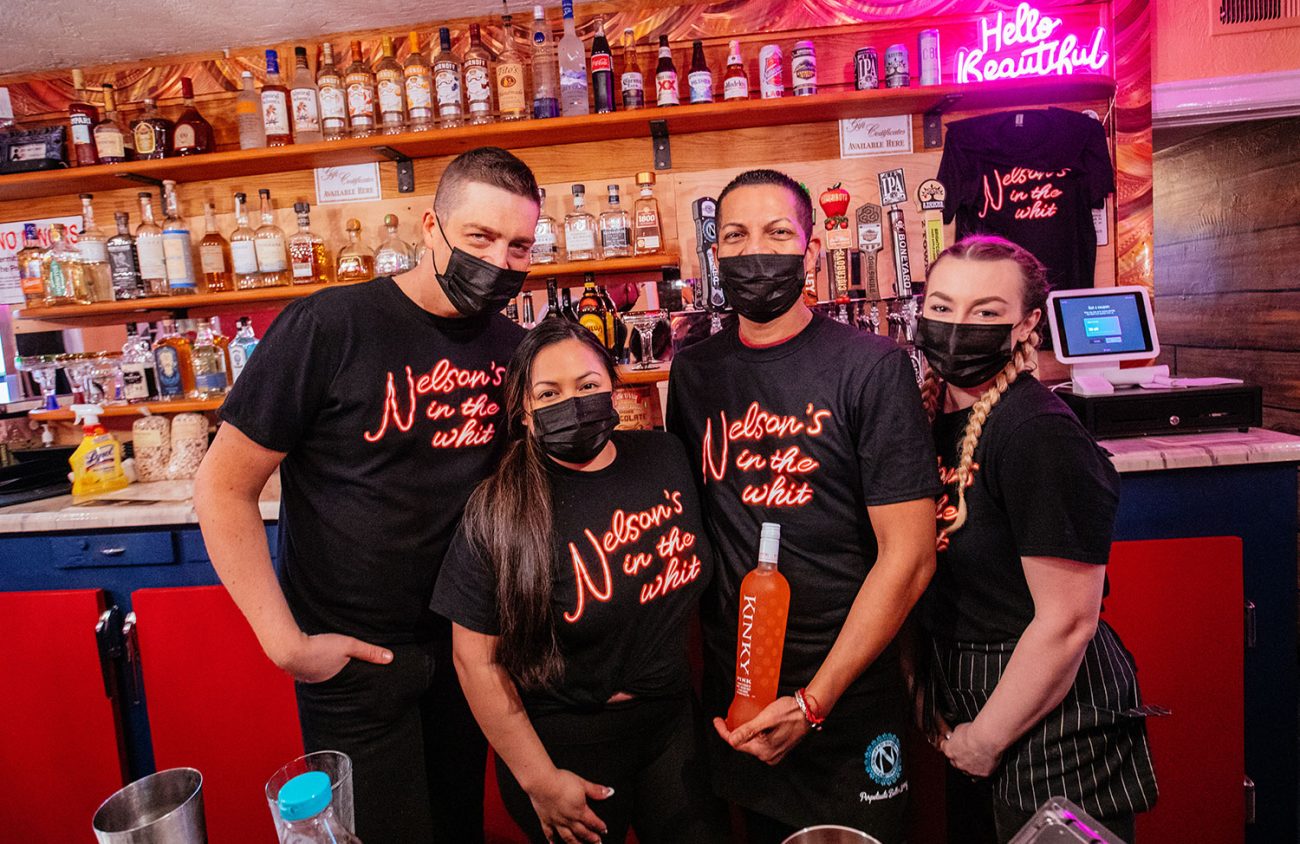A bass and drum beat bumps in the background at Nelson’s in the Whit, the newest addition to the Whiteaker’s neighborhood scene. As the song “Taki Taki” by DJ Snake plays over the stereo, customers begin to fill the building that was once Tiny Tavern six years ago.
The restaurant is busier than it usually is on Monday nights, and piercing the music and chatter are customers praising Nelson Lopez on how nice the new restaurant looks.
For five years, Lopez has been running a food cart in the Tiny Tavern parking lot. In November, he moved into the tavern itself, which is one of the neighborhood’s historic buildings.
Along with the Whiteaker’s Blair Island area, the Tiny Tavern building, at 394 Blair Boulevard, is recognized in the U.S. National Park Service’s National Register of Historic Places.
Lopez has changed the interior, surprising many customers who were familiar with the old Tiny Tavern and didn’t frequent the more upscale Board during its three-year stint in the building. As he settles into the business, he says he wants to provide the area with good food, bar drinks and — soon — a late night venue.
While Lopez isn’t the first occupant to move in since the tavern known as Tiny’s closed, his brick and mortar venture is a step toward restoring the presence of Latino-owned businesses in the neighborhood.
Nelson’s Taqueria, his food cart, is what’s helped him establish Nelson’s in the Whit. Like other food carts during the pandemic, he says, the cart was selling a lot of food, and there was always a line of customers waiting to place an order. “We were killing it,” he says. “Every day we’d have so many customers. We did great.”
The success of his food cart and popularity with the foodie community helped him secure the money to move into the old Tiny Tavern building.
On the city of Eugene’s 1993 application to nominate the neighborhood as a historic place, the document says Lucielle and R.B. Johnson purchased the property in 1945 to convert a farmhouse into the Tiny Tavern. Since then, the tavern has been a “working man’s tavern,” the document says.
In 2006, Lucielle Johnson sold the property and business to Jeff and Valerie Malos, who still own the property today, according to Lane County property records. In 2015, Tiny Tavern closed down, less than a year after Eugene Weekly reported that Jeff Malos had enlisted a chef to clean up the bar’s menu and environment.
In 2015, Board Restaurant moved in but closed three years later according to reddit posts from that time. One year later, the Dew Drop Inn bar and restaurant opened but didn’t survive the pandemic.
Life on Blair Island
In November 2021, Nelson’s in the Whit moved in, joining the building’s history of tenants.
Lopez’s move into a brick and mortar located in the Whit’s Blair Island is a step toward re-establishing Latino-owned businesses in the neighborhood. Blair Island is, according to the National Register of Historic Places registration form, the “unusual intersection” of Blair Boulevard, Van Buren Street and 4th Avenue and as far south as 5th.
Before becoming executive director of the equity advocacy nonprofit Oregon Just Transition Alliance and a local activist, Joel Iboa spent some of his childhood growing up in the Whiteaker neighborhood when there were more Latino-owned businesses.
Ninkasi’s founding in 2006 led the neighborhood to change in business makeup, Iboa says. He remembers attending elementary school with classrooms half-filled with other Latinx students.
One anchor of the Latino community in the Whit was the Centro Latino Americano building, which is still there. Iboa says he remembers going there in December for posada celebrations, a Latin American Christmas tradition. The community would do prayers and the adults would hand out cash and candy to the children, he says. “I remember the parking lot would get super full,” he says.
“There were a lot of immigrants in the neighborhood,” Iboa says. Part of the reason his family moved there, he adds, was because to rent an apartment didn’t require a lot of rental history and was an affordable place to live.
As the neighborhood experienced gentrification during the 2000s, there were only three Latinx-owned businesses, Iboa says. But with Lopez moving into the old Tiny Tavern building, it’s now five. “For a long time, I was sad that we were losing some of the Latinx influence that I grew up with in the ’90s and ’00s, but it feels like we’re getting it back,” he says.
Lopez will still run his food cart, which he says has a larger menu and can serve customers breakfast and lunch. Nelson’s in the Whit, though, has a two-sided dinner menu and daily and happy hour specials.
He says he’s waiting until spring or summer to be open for lunch. “I’m trying to be patient,” he adds, mentioning COVID as a reason for not expanding the menu just yet.
In the meantime, Lopez points to the bar as his moneymaker. Tacos at the cart are $2, he says. “You get one margarita, it’s $11. You drink three margaritas in one sitting? That’s more than $30.”
And it’s hard to have just one of Lopez’s margaritas. Lopez tells me that he and his staff make the margarita mixes in house every morning. He says his restaurant makes the best margaritas, and after drinking one, I think he’s right. The strawberry margarita carries a lot of flavors — it’s sweet, filled with blended strawberry juice and tequila along with tart lime.
Lopez says the restaurant’s more popular items are chile rellenos, enchiladas and carne asada fries.
The enchilada plate is unlike that of any other restaurant. Typically, American Mexican restaurants drown flour tortilla-based enchiladas in a chile or verde sauce. Nelson’s in the Whit takes a more toned down approach.
His enchiladas feature corn tortillas and are more sparing on the sauce so it doesn’t overwhelm the other flavors. And that’s good because that approach allows you to enjoy how tender the chicken is.
Lopez says other restaurants usually have a chicken broth based enchilada sauce. “I’m trying to have really good vegan enchilada sauce,” he says. “We put a lot of seasonings and flavor there. When you try my enchilada sauce, you taste all the good flavors.”
In the future, Lopez says he wants Nelson’s in the Whit to be a late night venue that doesn’t just have local bands. The restaurant’s grand opening featured the electro-swing band High Step Society, but he says he wants to bring in a little bit of everything. “I am trying to bring the comedians. I am trying to bring the drag queen shows,” he says. “Why not the go-go dancers?”
When customers walk into Nelson’s in the Whit, those who are familiar with Tiny Tavern’s older history are surprised to see such a change in interior, Lopez says.
One 2011 Tiny Tavern review on Yelp captures the former environment of the bar: “Ever wondered what the gateway to hell looks like?”
Lopez says he altered a lot of things when they moved into the building, and customers like the change. “Everybody who comes here has huge expectations. They think, ‘It’s Tiny, it’s ugly,’ how it used to be and how everybody was scared,” Lopez says.
The neighborhood has appreciated the change, too, Lopez says. “They feel they are happier here in this building,” he says “They tell me I belong here and are happy I’m here.”

